Global Trends and Research Hotspots in Long COVID: A Bibliometric Analysis
Abstract
:1. Introduction
2. Materials and Methods
2.1. Data
- (1)
- Scopus is an interdisciplinary database and 100% inclusive of MEDLINE;
- (2)
- Scopus delivers the broadest abstract and citation database of peer-reviewed scientific literature;
- (3)
- Scopus has advantages in the aspect of searching data, exporting literature, and analyzing citations.
2.2. Methods
3. Results
3.1. Leading Countries
3.2. Leading Journals
3.3. Leading Authors
3.4. Leading Articles
3.5. Research Hotspots
- Red cluster: pathophysiology.
- Blue cluster: symptoms.
- Yellow cluster: treatment.
- Green cluster: epidemiology.
4. Discussion
4.1. Contribution of Countries, Journals, and authors
4.2. Analysis of Research Hotspots
4.3. Research Opportunities
- Care plan.
- Other field effects of Long COVID.
- Special populations with long COVID.
4.4. Limitations
5. Conclusions
Author Contributions
Funding
Institutional Review Board Statement
Informed Consent Statement
Data Availability Statement
Conflicts of Interest
References
- Garner, P. Paul Garner: For 7 Weeks I Have Been through a Roller Coaster of Ill Health, Extreme Emotions, and Utter Exhaustion. BMJ 2020. Available online: https://blogs.bmj.com/bmj/2020/05/05/paul-garner-people-who-have-a-more-protracted-illness-need-help-to-understand-and-cope-with-the-constantly-shifting-bizarre-symptoms (accessed on 25 December 2021).
- Mahase, E. COVID-19: What do we know about “long covid”? BMJ 2020, 370, m2815. [Google Scholar] [CrossRef] [PubMed]
- Centers for Disease Control and Prevention. Post-COVID Conditions: Information for Healthcare Providers. Available online: https://www.cdc.gov/coronavirus/2019-ncov/hcp/clinical-care/post-covid-conditions.html (accessed on 25 December 2021).
- Service, N.H. Long-Term Effects of Coronavirus (Long COVID). Available online: https://www.nhs.uk/conditions/coronavirus-covid-19/long-term-effects-of-coronavirus-long-covid/ (accessed on 25 December 2021).
- Gorna, R.; MacDermott, N.; Rayner, C.; O’Hara, M.; Evans, S.; Agyen, L.; Nutland, W.; Rogers, N.; Hastie, C. Long COVID guidelines need to reflect lived experience. Lancet 2021, 397, 455–457. [Google Scholar] [CrossRef]
- Nalbandian, A.; Sehgal, K.; Gupta, A.; Madhavan, M.V.; McGroder, C.; Stevens, J.S.; Cook, J.R.; Nordvig, A.S.; Shalev, D.; Sehrawat, T.S.; et al. Post-acute COVID-19 syndrome. Nat. Med. 2021, 27, 601–615. [Google Scholar] [CrossRef]
- Venkatesan, P. NICE guideline on long COVID. Lancet Respir. Med. 2021, 9, 129. [Google Scholar] [CrossRef]
- Taribagil, P.; Creer, D.; Tahir, H. ‘Long COVID’ syndrome. BMJ Case Rep. 2021, 14, e241485. [Google Scholar] [CrossRef]
- Lopez-Leon, S.; Wegman-Ostrosky, T.; Perelman, C.; Sepulveda, R.; Rebolledo, P.A.; Cuapio, A.; Villapol, S. More than 50 long-term effects of COVID-19: A systematic review and meta-analysis. Sci. Rep. 2021, 11, 16144. [Google Scholar] [CrossRef]
- Snyder, H. Literature review as a research methodology: An overview and guidelines. J. Bus. Res. 2019, 104, 333–339. [Google Scholar] [CrossRef]
- Callard, F.; Perego, E. How and why patients made Long Covid. Soc. Sci. Med. 2021, 268, 113426. [Google Scholar] [CrossRef]
- Blomberg, B.; Mohn, K.G.-I.; Brokstad, K.A.; Zhou, F.; Linchausen, D.W.; Hansen, B.-A.; Lartey, S.; Onyango, T.B.; Kuwelker, K.; Sævik, M.; et al. Long COVID in a prospective cohort of home-isolated patients. Nat. Med. 2021, 27, 1607–1613. [Google Scholar] [CrossRef]
- Huang, C.; Huang, L.; Wang, Y.; Li, X.; Ren, L.; Gu, X.; Kang, L.; Guo, L.; Liu, M.; Zhou, X.; et al. 6-month consequences of COVID-19 in patients discharged from hospital: A cohort study. Lancet 2021, 397, 220–232. [Google Scholar] [CrossRef]
- Bergwerk, M.; Gonen, T.; Lustig, Y.; Amit, S.; Lipsitch, M.; Cohen, C.; Mandelboim, M.; Levin, E.G.; Rubin, C.; Indenbaum, V.; et al. Covid-19 Breakthrough Infections in Vaccinated Health Care Workers. N. Engl. J. Med. 2021, 385, 1474–1484. [Google Scholar] [CrossRef] [PubMed]
- Meagher, T. Long COVID—An Early Perspective. J. Insur. Med. 2021, 49, 19–23. [Google Scholar] [CrossRef]
- Berger, Z.; Altiery De Jesus, V.; Assoumou, S.A.; Greenhalgh, T. Long COVID and Health Inequities: The Role of Primary Care. Milbank Q. 2021, 99, 519–541. [Google Scholar] [CrossRef] [PubMed]
- Inzitari, M.; Risco, E.; Cesari, M.; Buurman, B.M.; Kuluski, K.; Davey, V.; Bennett, L.; Varela, J.; Prvu Bettger, J. Nursing Homes and Long Term Care After COVID-19: A New ERA? J. Nutr. Health Aging 2020, 24, 1042–1046. [Google Scholar] [CrossRef] [PubMed]
- Wikipedia. Long COVID. Available online: https://en.jinzhao.wiki/wiki/Long_COVID#cite_note-JMV-20201023-1 (accessed on 2 January 2022).
- Centers for Disease Control and Prevention. Post-COVID Conditions. Available online: https://www.cdc.gov/coronavirus/2019-ncov/long-term-effects/index.html?CDC_AA_refVal=https%3A%2F%2Fwww.cdc.gov%2Fcoronavirus%2F2019-ncov%2Flong-term-effects.html (accessed on 2 January 2022).
- National Institute for Health and Care Excellence. COVID-19 Rapid Guideline: Managing the Long-Term Effects of COVID-19. Available online: https://www.nice.org.uk/guidance/ng188 (accessed on 2 January 2022).
- Baig, A.M. Chronic COVID syndrome: Need for an appropriate medical terminology for long-COVID and COVID long-haulers. J. Med. Virol. 2021, 93, 2555–2556. [Google Scholar] [CrossRef]
- Ward, H.; Flower, B.; Garcia, P.J.; Ong, S.W.X.; Altmann, D.M.; Delaney, B.; Smith, N.; Elliott, P.; Cooke, G. Global surveillance, research, and collaboration needed to improve understanding and management of long COVID. Lancet 2021, 398, 2057–2059. [Google Scholar] [CrossRef]
- Page, M.J.; McKenzie, J.E.; Bossuyt, P.M.; Boutron, I.; Hoffmann, T.C.; Mulrow, C.D.; Shamseer, L.; Tetzlaff, J.M.; Akl, E.A.; Brennan, S.E.; et al. The PRISMA 2020 statement: An updated guideline for reporting systematic reviews. PLoS Med. 2021, 18, e1003583. [Google Scholar] [CrossRef]
- Zupic, I.; Čater, T. Bibliometric Methods in Management and Organization. Organ. Res. Methods 2014, 18, 429–472. [Google Scholar] [CrossRef]
- Aria, M.; Cuccurullo, C. bibliometrix: An R-tool for comprehensive science mapping analysis. J. Informetr. 2017, 11, 959–975. [Google Scholar] [CrossRef]
- Estiri, H.; Strasser, Z.H.; Brat, G.A.; Semenov, Y.R.; Aaron, J.R.; Agapito, G.; Albayrak, A.; Alessiani, M.; Amendola, D.F.; Anthony, L.L.L.J.; et al. Evolving phenotypes of non-hospitalized patients that indicate long COVID. BMC Med. 2021, 19, 249. [Google Scholar] [CrossRef] [PubMed]
- Munblit, D.; Bobkova, P.; Spiridonova, E.; Shikhaleva, A.; Gamirova, A.; Blyuss, O.; Nekliudov, N.; Bugaeva, P.; Andreeva, M.; DunnGalvin, A.; et al. Incidence and risk factors for persistent symptoms in adults previously hospitalized for COVID-19. Clin. Exp. Allergy 2021, 51, 1107–1120. [Google Scholar] [CrossRef]
- Greenhalgh, T.; Knight, M.; A’Court, C.; Buxton, M.; Husain, L. Management of post-acute covid-19 in primary care. BMJ 2020, 370, m3026. [Google Scholar] [CrossRef] [PubMed]
- Sudre, C.H.; Murray, B.; Varsavsky, T.; Graham, M.S.; Penfold, R.S.; Bowyer, R.C.; Pujol, J.C.; Klaser, K.; Antonelli, M.; Canas, L.S.; et al. Attributes and predictors of long COVID. Nat. Med. 2021, 27, 626–631. [Google Scholar] [CrossRef] [PubMed]
- Yong, S.J. Long COVID or post-COVID-19 syndrome: Putative pathophysiology, risk factors, and treatments. Infect. Dis. 2021, 53, 737–754. [Google Scholar] [CrossRef]
- Gupta, A.; Madhavan, M.V.; Sehgal, K.; Nair, N.; Mahajan, S.; Sehrawat, T.S.; Bikdeli, B.; Ahluwalia, N.; Ausiello, J.C.; Wan, E.Y.; et al. Extrapulmonary manifestations of COVID-19. Nat. Med. 2020, 26, 1017–1032. [Google Scholar] [CrossRef]
- Korompoki, E.; Gavriatopoulou, M.; Hicklen, R.S.; Ntanasis-Stathopoulos, I.; Kastritis, E.; Fotiou, D.; Stamatelopoulos, K.; Terpos, E.; Kotanidou, A.; Hagberg, C.A.; et al. Epidemiology and organ specific sequelae of post-acute COVID19: A narrative review. J. Infect. 2021, 83, 1–16. [Google Scholar] [CrossRef]
- Hassan, E.B.; Phu, S.; Warburton, E.; Humaith, N.; Wijeratne, T. Frailty in Stroke—A Narrated Review. Life 2021, 11, 891. [Google Scholar] [CrossRef]
- Jason, L.A.; Islam, M.F.; Conroy, K.; Cotler, J.; Torres, C.; Johnson, M.; Mabie, B. COVID-19 symptoms over time: Comparing long-haulers to ME/CFS. Fatigue Biomed. Health Behav. 2021, 9, 59–68. [Google Scholar] [CrossRef]
- Søraas, A.; Kalleberg, K.T.; Dahl, J.A.; Søraas, C.L.; Myklebust, T.Å.; Axelsen, E.; Lind, A.; Bævre-Jensen, R.; Jørgensen, S.B.; Istre, M.S.; et al. Persisting symptoms three to eight months after non-hospitalized COVID-19, a prospective cohort study. PLoS ONE 2021, 16, e0256142. [Google Scholar] [CrossRef]
- Mandal, S.; Barnett, J.; Brill, S.E.; Brown, J.S.; Denneny, E.K.; Hare, S.S.; Heightman, M.; Hillman, T.E.; Jacob, J.; Jarvis, H.C.; et al. Long-COVID’: A cross-sectional study of persisting symptoms, biomarker and imaging abnormalities following hospitalisation for COVID-19. Thorax 2021, 76, 396–398. [Google Scholar] [CrossRef] [PubMed]
- Cha, C.; Baek, G. Symptoms and management of long COVID: A scoping review. J. Clin. Nurs. 2021. [Google Scholar] [CrossRef] [PubMed]
- Jennings, G.; Monaghan, A.; Xue, F.; Mockler, D.; Romero-Ortuño, R. A systematic review of persistent symptoms and residual abnormal functioning following acute covid-19: Ongoing symptomatic phase vs. post-covid-19 syndrome. J. Clin. Med. 2021, 10, 5913. [Google Scholar] [CrossRef] [PubMed]
- Karaarslan, F.; Güneri, F.D.; Kardeş, S. Long COVID: Rheumatologic/musculoskeletal symptoms in hospitalized COVID-19 survivors at 3 and 6 months. Clin. Rheumatol. 2021, 41, 289–296. [Google Scholar] [CrossRef] [PubMed]
- Long, Q.; Li, J.; Hu, X.; Bai, Y.; Zheng, Y.; Gao, Z. Follow-Ups on Persistent Symptoms and Pulmonary Function Among Post-Acute COVID-19 Patients: A Systematic Review and Meta-Analysis. Front. Med. 2021, 8, 702635. [Google Scholar] [CrossRef] [PubMed]
- Osikomaiya, B.; Erinoso, O.; Wright, K.O.; Odusola, A.O.; Thomas, B.; Adeyemi, O.; Bowale, A.; Adejumo, O.; Falana, A.; Abdus-salam, I.; et al. ‘Long COVID’: Persistent COVID-19 symptoms in survivors managed in Lagos State, Nigeria. BMC Infect. Dis. 2021, 21, 304. [Google Scholar] [CrossRef] [PubMed]
- Džubera, A.; Chochol, J.; Illéš, R.; Chocholová, A.; Zemková, E. Vertebral algic syndrome treatment in long COVID—Cases reports. Int. J. Environ. Res. Public Health 2021, 18, 11457. [Google Scholar] [CrossRef]
- Wu, L.; Wu, Y.; Xiong, H.; Mei, B.; You, T. Persistence of Symptoms After Discharge of Patients Hospitalized Due to COVID-19. Front. Med. 2021, 8, 761314. [Google Scholar] [CrossRef]
- Aiyegbusi, O.L.; Hughes, S.E.; Turner, G.; Rivera, S.C.; McMullan, C.; Chandan, J.S.; Haroon, S.; Price, G.; Davies, E.H.; Nirantharakumar, K.; et al. Symptoms, complications and management of long COVID: A review. J. R. Soc. Med. 2021, 114, 428–442. [Google Scholar] [CrossRef]
- Dennis, A.; Wamil, M.; Alberts, J.; Oben, J.; Cuthbertson, D.J.; Wootton, D.; Crooks, M.; Gabbay, M.; Brady, M.; Hishmeh, L.; et al. Multiorgan impairment in low-risk individuals with post-COVID-19 syndrome: A prospective, community-based study. BMJ Open 2021, 11, e048391. [Google Scholar] [CrossRef]
- Fumagalli, C.; Zocchi, C.; Tassetti, L.; Silverii, M.V.; Amato, C.; Livi, L.; Giovannoni, L.; Verrillo, F.; Bartoloni, A.; Marcucci, R.; et al. Factors associated with persistence of symptoms 1 year after COVID-19: A longitudinal, prospective phone-based interview follow-up cohort study. Eur. J. Intern. Med. 2021, 97, 36–41. [Google Scholar] [CrossRef] [PubMed]
- Renaud-Charest, O.; Lui, L.M.W.; Eskander, S.; Ceban, F.; Ho, R.; Di Vincenzo, J.D.; Rosenblat, J.D.; Lee, Y.; Subramaniapillai, M.; McIntyre, R.S. Onset and frequency of depression in post-COVID-19 syndrome: A systematic review. J. Psychiatr. Res. 2021, 144, 129–137. [Google Scholar] [CrossRef] [PubMed]
- Hayes, L.D.; Ingram, J.; Sculthorpe, N.F. More Than 100 Persistent Symptoms of SARS-CoV-2 (Long COVID): A Scoping Review. Front. Med. 2021, 8, 2028. [Google Scholar] [CrossRef] [PubMed]
- Boutou, A.K.; Asimakos, A.; Kortianou, E.; Vogiatzis, I.; Tzouvelekis, A. Long covid-19 pulmonary sequelae and management considerations. J. Pers. Med. 2021, 11, 838. [Google Scholar] [CrossRef]
- Rabady, S.; Altenberger, J.; Brose, M.; Denk-Linnert, D.M.; Fertl, E.; Götzinger, F.; de la Cruz Gomez Pellin, M.; Hofbaur, B.; Hoffmann, K.; Hoffmann-Dorninger, R.; et al. Guideline S1: Long COVID: Diagnostics and treatment strategies. Wien. Klin. Wochen. 2021, 133, 237–278. [Google Scholar] [CrossRef]
- Robbins, T.; Gonevski, M.; Clark, C.; Baitule, S.; Sharma, K.; Magar, A.; Patel, K.; Sankar, S.; Kyrou, I.; Ali, A.; et al. Hyperbaric oxygen therapy for the treatment of long COVID: Early evaluation of a highly promising intervention. Clin. Med. J. R. Coll. Phys. Lond. 2021, 21, E629–E632. [Google Scholar] [CrossRef]
- Vollbracht, C.; Kraft, K. Feasibility of vitamin c in the treatment of post viral fatigue with focus on long covid, based on a systematic review of iv vitamin c on fatigue. Nutrients 2021, 13, 1154. [Google Scholar] [CrossRef]
- Mitrani, M.I.; Bellio, M.A.; Meglin, A.; Khan, A.; Xu, X.; Haskell, G.; Arango, A.; Shapiro, G.C. Treatment of a COVID-19 long hauler with an amniotic fluid-derived extracellular vesicle biologic. Respir. Med. Case Rep. 2021, 34, 101502. [Google Scholar] [CrossRef]
- Najafloo, R.; Majidi, J.; Asghari, A.; Aleemardani, M.; Kamrava, S.K.; Simorgh, S.; Seifalian, A.; Bagher, Z.; Seifalian, A.M. Mechanism of Anosmia Caused by Symptoms of COVID-19 and Emerging Treatments. ACS Chem. Neurosci. 2021, 12, 3795–3805. [Google Scholar] [CrossRef]
- Łuckoś, M.; Cielebąk, K.; Kamiński, P. Eeg neurofeedback in the treatment of cognitive dysfunctions after the infection of sars-cov-2 and long covid-19. Acta Neuropsychol. 2021, 19, 361–372. [Google Scholar] [CrossRef]
- Pilloni, G.; Bikson, M.; Badran, B.W.; George, M.S.; Kautz, S.A.; Okano, A.H.; Baptista, A.F.; Charvet, L.E. Update on the Use of Transcranial Electrical Brain Stimulation to Manage Acute and Chronic COVID-19 Symptoms. Front. Hum. Neurosci. 2020, 14, 493. [Google Scholar] [CrossRef] [PubMed]
- Bai, F.; Tomasoni, D.; Falcinella, C.; Barbanotti, D.; Castoldi, R.; Mulè, G.; Augello, M.; Mondatore, D.; Allegrini, M.; Cona, A.; et al. Female gender is associated with long COVID syndrome: A prospective cohort study. Clin. Microbiol. Infect. 2021; in press. [Google Scholar] [CrossRef]
- Mohiuddin Chowdhury, A.T.M.; Karim, M.R.; Ali, M.A.; Islam, J.; Li, Y.; He, S. Clinical Characteristics and the Long-Term Post-recovery Manifestations of the COVID-19 Patients—A Prospective Multicenter Cross-Sectional Study. Front. Med. 2021, 8, 1104. [Google Scholar] [CrossRef] [PubMed]
- Bliddal, S.; Banasik, K.; Pedersen, O.B.; Nissen, J.; Cantwell, L.; Schwinn, M.; Tulstrup, M.; Westergaard, D.; Ullum, H.; Brunak, S.; et al. Acute and persistent symptoms in non-hospitalized PCR-confirmed COVID-19 patients. Sci. Rep. 2021, 11, 13153. [Google Scholar] [CrossRef] [PubMed]
- Asadi-Pooya, A.A.; Nemati, H.; Shahisavandi, M.; Akbari, A.; Emami, A.; Lotfi, M.; Rostamihosseinkhani, M.; Barzegar, Z.; Kabiri, M.; Zeraatpisheh, Z.; et al. Long COVID in children and adolescents. World J. Pediatr. 2021, 17, 495–499. [Google Scholar] [CrossRef] [PubMed]
- Man, J.P.; Weinkauf, J.G.; Tsang, M.; Sin, J.H.D.D. Why do Some Countries Publish More Than Others? An International Comparison of Research Funding, English Proficiency and Publication Output in Highly Ranked General Medical Journals. Eur. J. Epidemiol. 2004, 19, 811–817. [Google Scholar] [CrossRef]
- Pope, R. Available online: https://twitter.com/preshitorian/status/1242831605330313216 (accessed on 8 January 2022).
- Tahamtan, I.; Safipour Afshar, A.; Ahamdzadeh, K. Factors affecting number of citations: A comprehensive review of the literature. Scientometrics 2016, 107, 1195–1225. [Google Scholar] [CrossRef]
- Shaban, S.; Aw, T.-C. Trend towards multiple authorship in occupational medicine journals. J. Occup. Med. Toxicol. 2009, 4, 3. [Google Scholar] [CrossRef] [Green Version]
- Erlen, J.A.; Siminoff, L.A.; Sereika, S.M.; Sutton, L.B. Multiple authorship: Issues and recommendations. J. Prof. Nurs. 1997, 13, 262–270. [Google Scholar] [CrossRef]
- Wang, S.T.; Lv, X.L. Hot Topics and Evolution of Frontier Research in Early Education: A Bibliometric Mapping of the Research Literature (2001–2020). Sustainability 2021, 13, 9216. [Google Scholar] [CrossRef]
- Fusco, G. Twenty Years of Common Agricultural Policy in Europe: A Bibliometric Analysis. Sustainability 2021, 13, 10650. [Google Scholar] [CrossRef]
- Duan, Y.R.; Guan, Q. Predicting potential knowledge convergence of solar energy: Bibliometric analysis based on link prediction model. Scientometrics 2021, 126, 3749–3773. [Google Scholar] [CrossRef]
- Ji, L.; Liu, C.; Huang, L.; Huang, G. The evolution of Resources Conservation and Recycling over the past 30 years: A bibliometric overview. Resour. Conserv. Recycl. 2018, 134, 34–43. [Google Scholar] [CrossRef]
- Soriano, J.B.; Murthy, S.; Marshall, J.C.; Relan, P.; Diaz, J.V. A clinical case definition of post-COVID-19 condition by a Delphi consensus. Lancet Infect. Dis. 2021; in press. [Google Scholar]
- Marshall, H.; Stewart, N.J.; Chan, H.-F.; Rao, M.; Norquay, G.; Wild, J.M. In vivo methods and applications of xenon-129 magnetic resonance. Prog. Nucl. Magn. Reson. Spectrosc. 2021, 122, 42–62. [Google Scholar] [CrossRef] [PubMed]
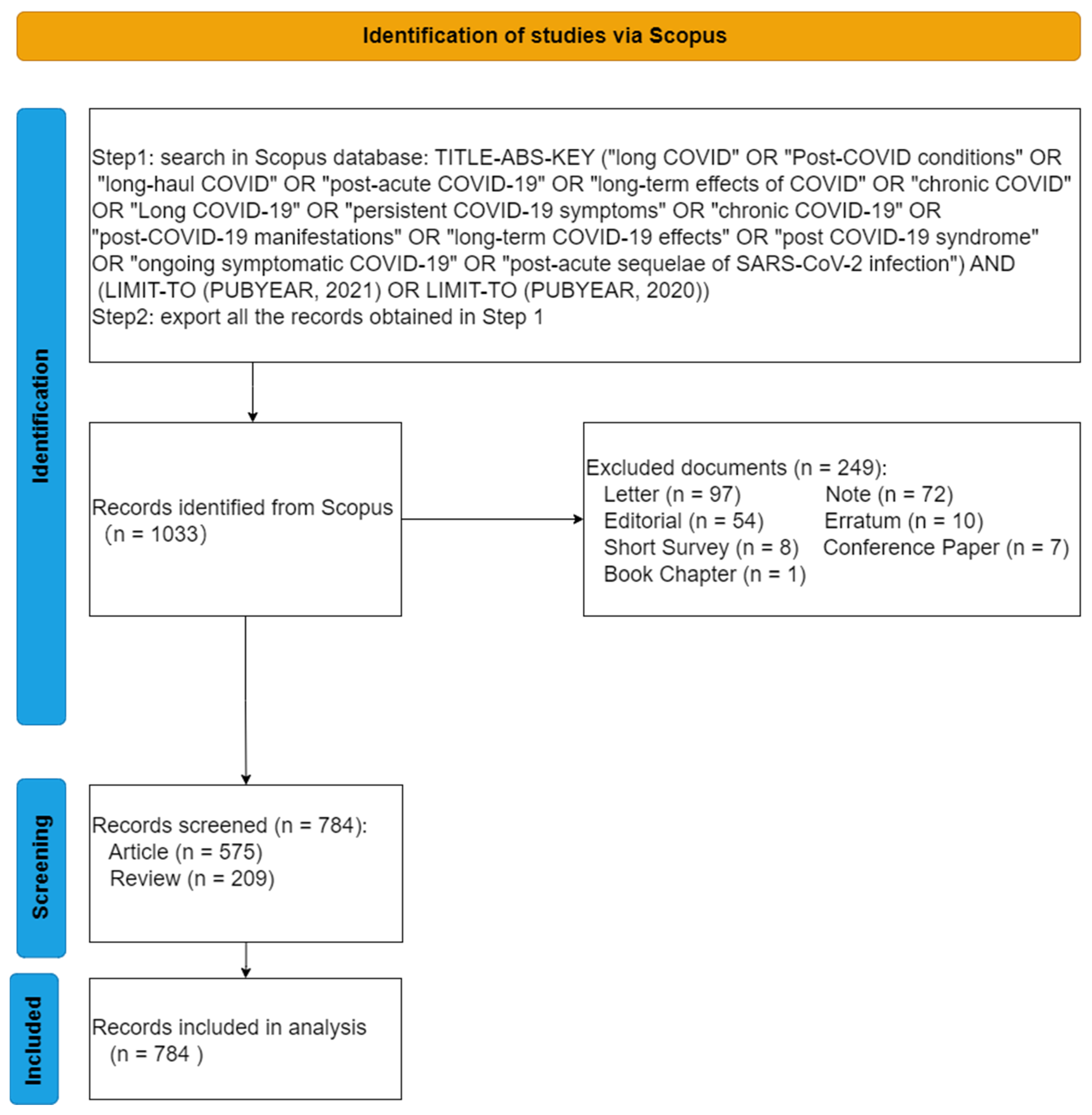
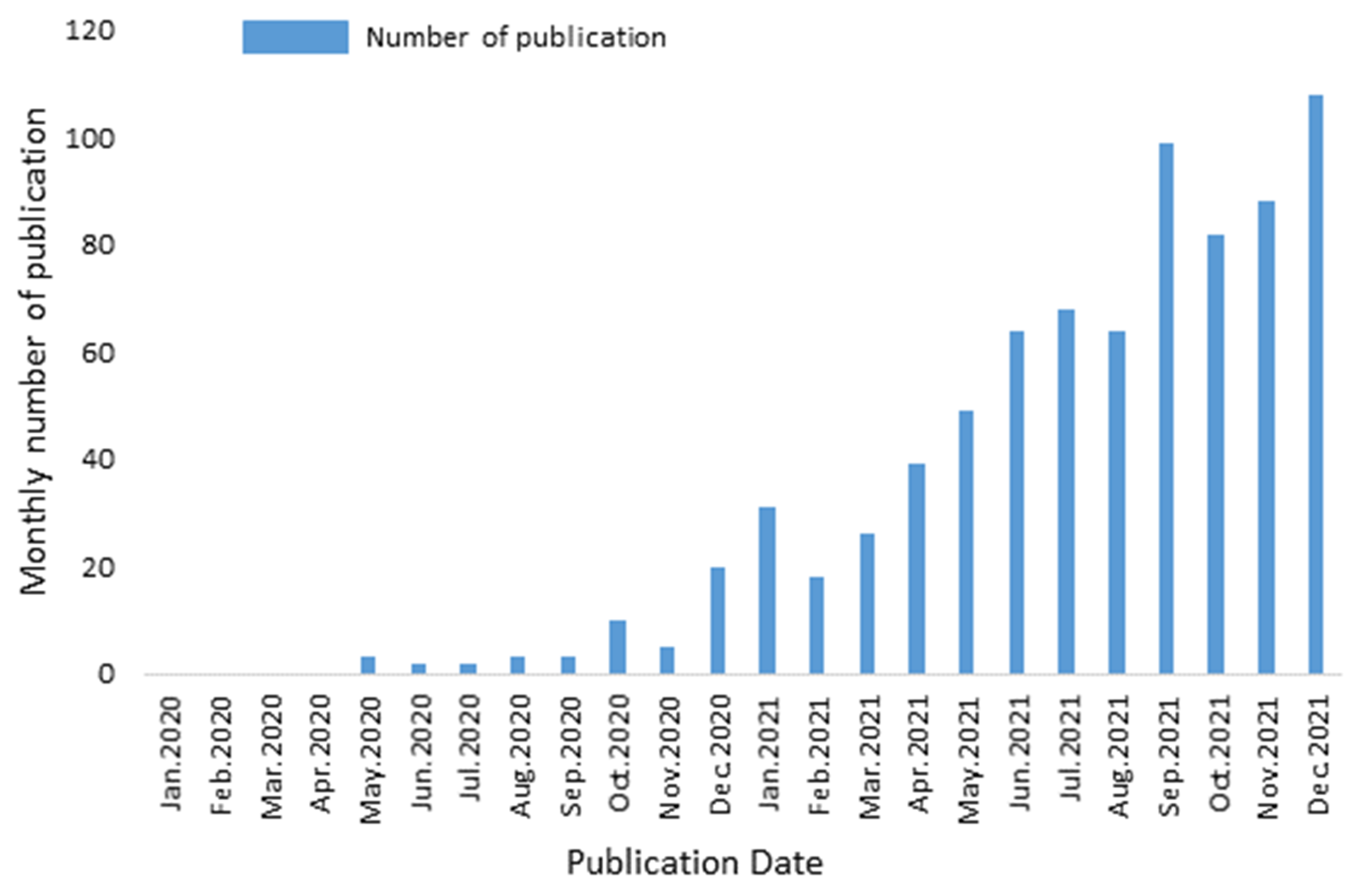
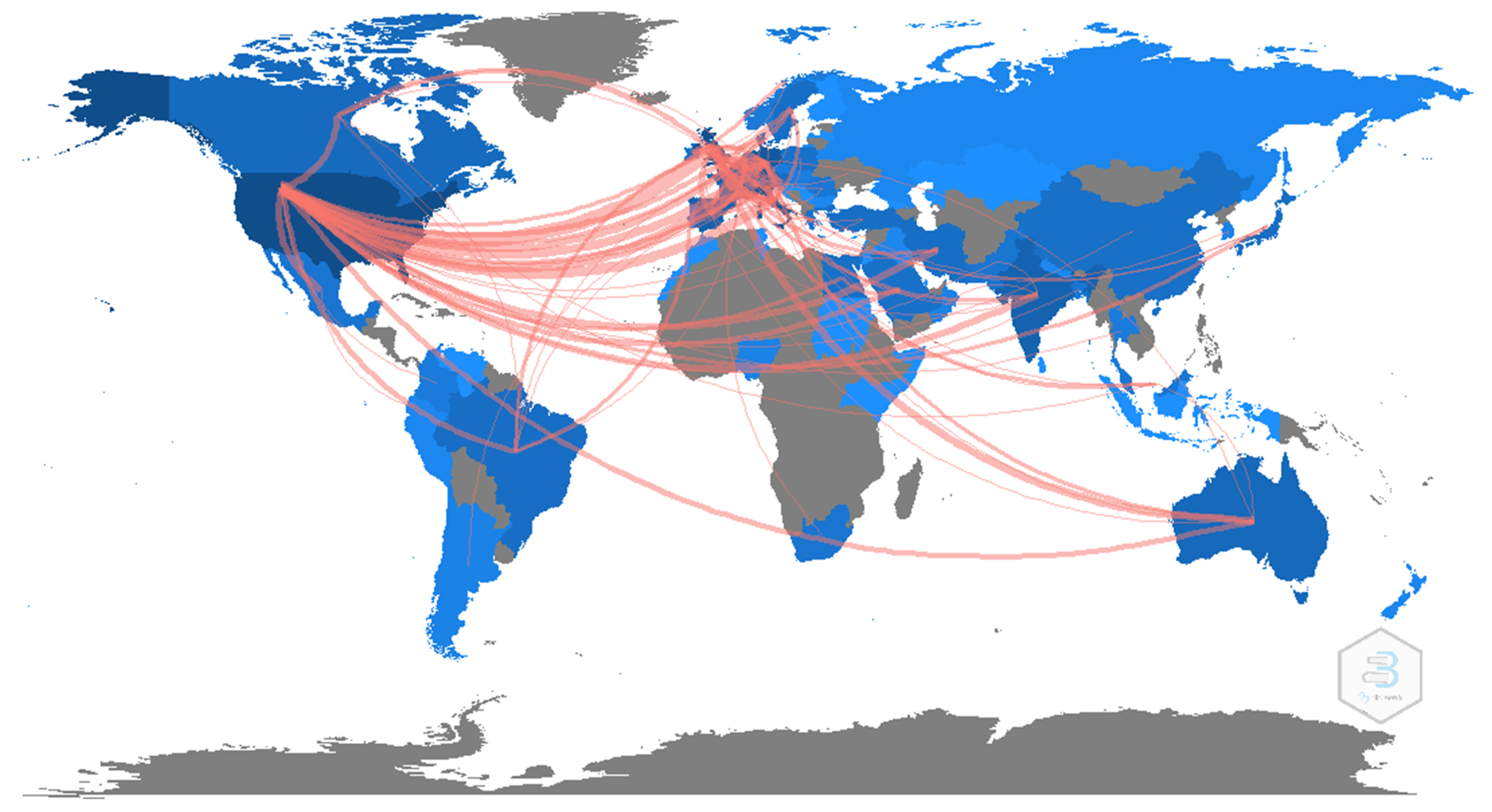
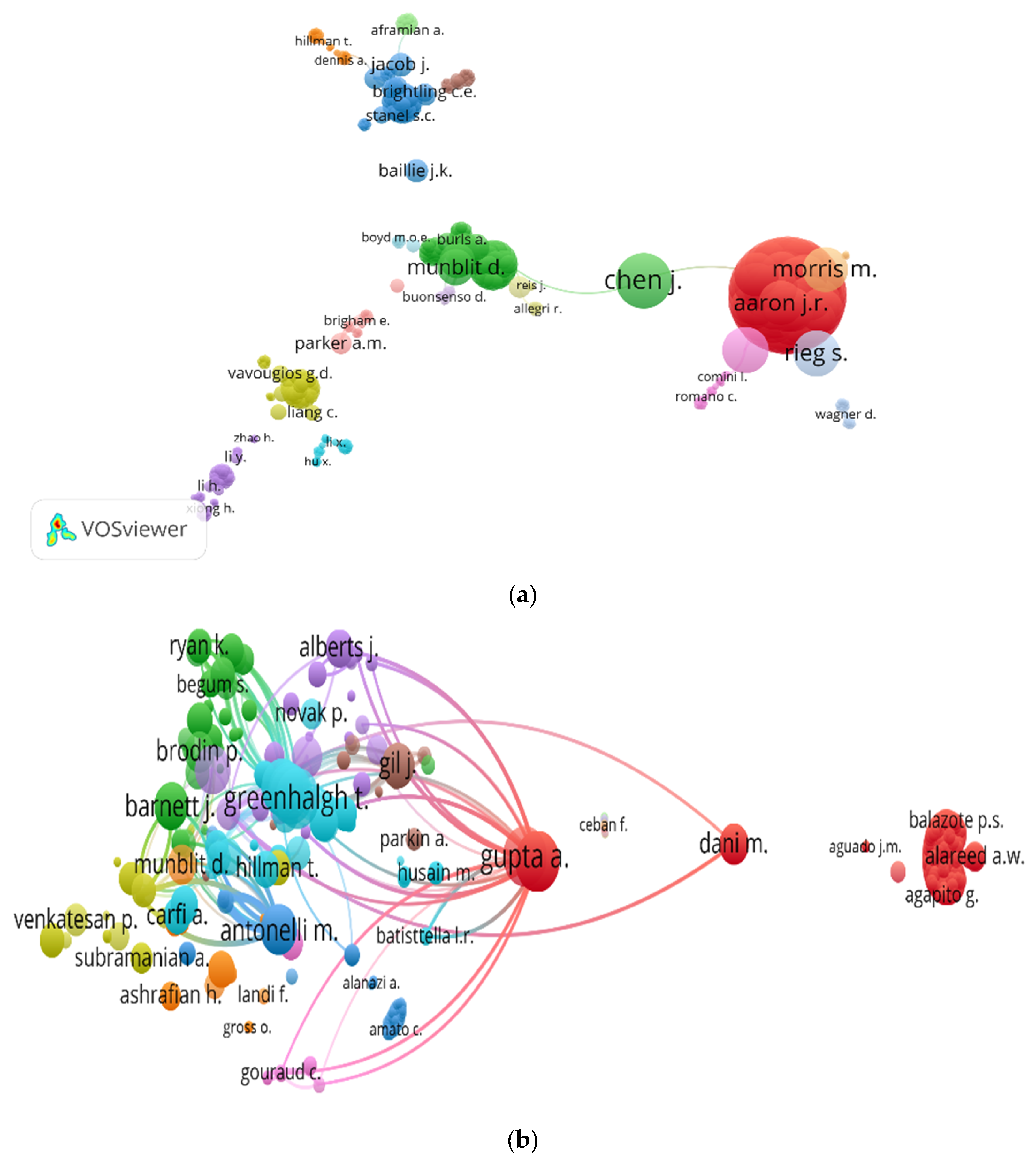
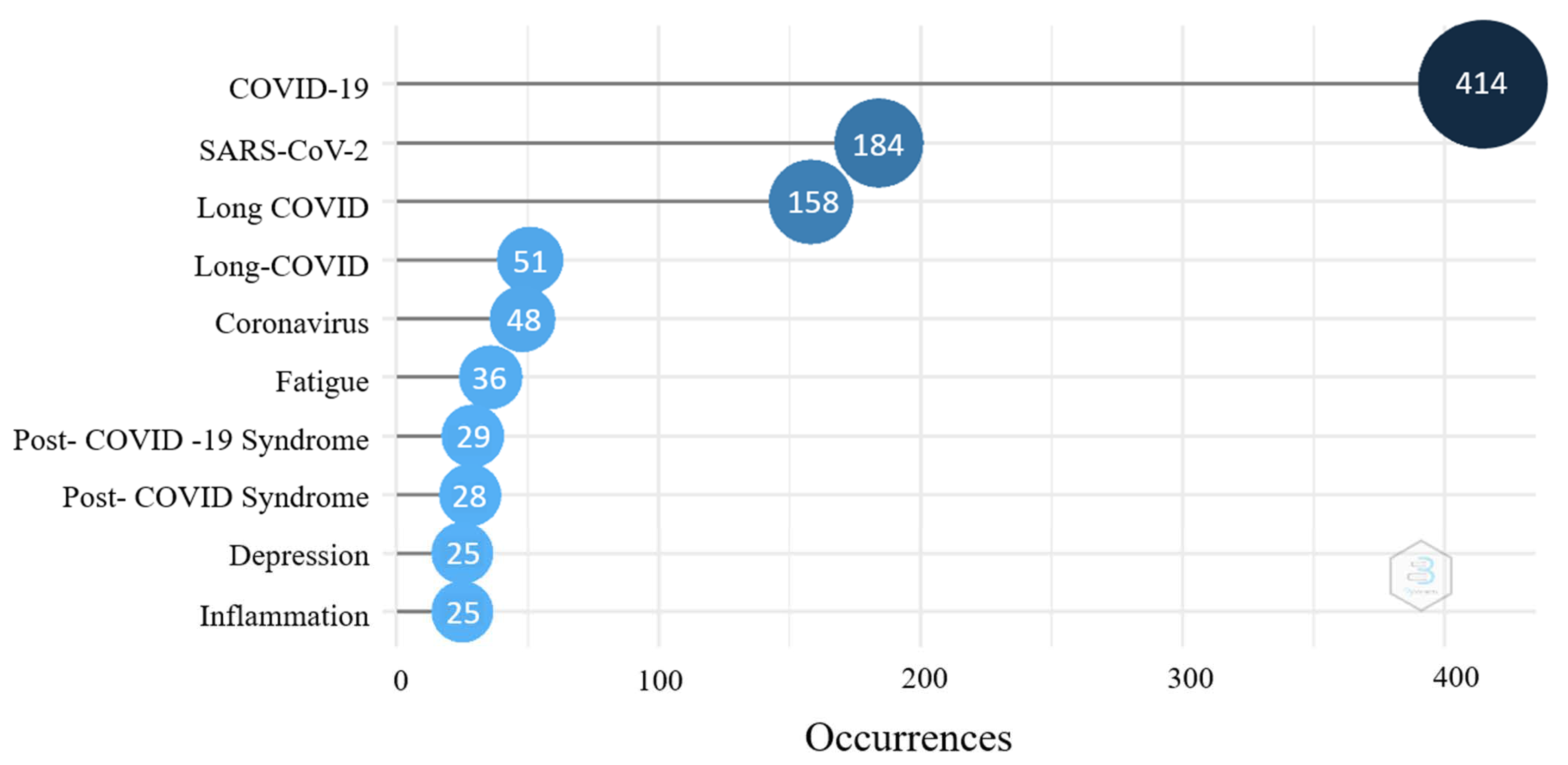
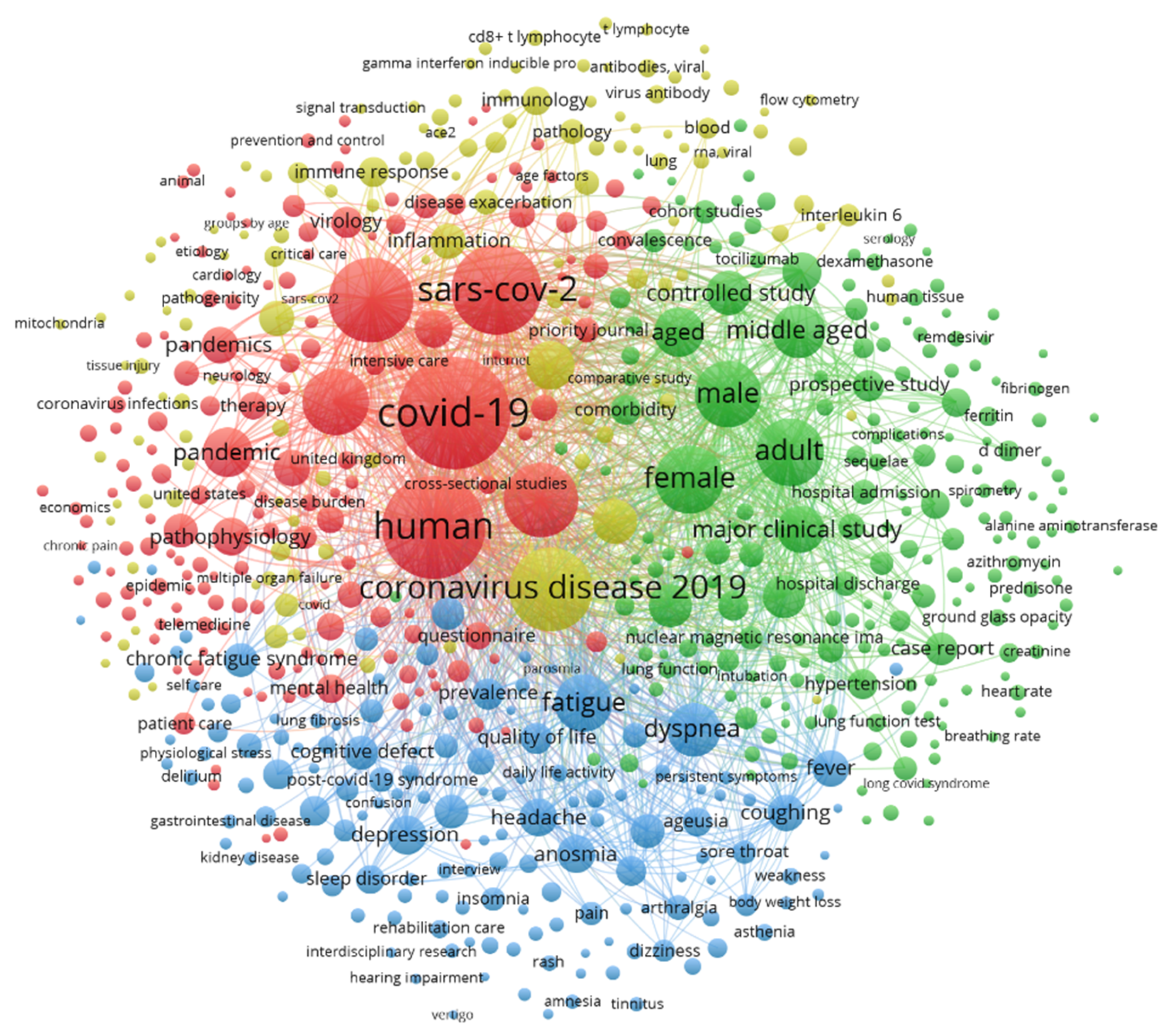
| Rank1 1 | Country | Number of Articles (%) | Rank2 2 | Country | Citations | APC 3 | MMP 4 |
|---|---|---|---|---|---|---|---|
| 1 | United States | 117 (14.9%) | 1 | United Kingdom | 1027 | 13.88 | July 2021 |
| 2 | United Kingdom | 74 (9.4%) | 2 | United States | 879 | 7.51 | June 2021 |
| 3 | Italy | 71 (9.1%) | 3 | Italy | 275 | 3.87 | August 2021 |
| 4 | Germany | 46 (5.9%) | 4 | Spain | 192 | 7.11 | September 2021 |
| 5 | China | 41 (5.2%) | 5 | China | 174 | 4.24 | July 2021 |
| 6 | Spain | 27 (3.4%) | 6 | Sweden | 154 | 25.67 | April 2021 |
| 7 | France | 23 (2.9%) | 7 | Germany | 139 | 3.02 | September 2021 |
| 8 | India | 20 (2.6%) | 8 | India | 78 | 3.90 | July 2021 |
| 9 | Australia | 13 (1.7%) | 9 | France | 76 | 3.30 | October 2021 |
| 10 | Canada | 13 (1.7%) | 10 | Denmark | 70 | 7.00 | August 2021 |
| Rank1 1 | Journal | Number of Articles | Rank2 2 | Journal | Citations | MMP 3 |
|---|---|---|---|---|---|---|
| 1 | International Journal of Environmental Research and Public Health | 20 | 1 | Nature Medicine | 678 | April 2021 |
| 2 | Journal of Clinical Medicine | 20 | 2 | British Medical Journal | 447 | April 2021 |
| 3 | PloS ONE | 14 | 3 | Thorax | 135 | April 2021 |
| 4 | Frontiers in Immunology | 11 | 4 | Journal of Infection | 126 | July 2021 |
| 5 | Frontiers in Medicine | 11 | 5 | Acta Paediatrica | 118 | July 2021 |
| 6 | Viruses | 10 | 6 | International Journal of Environmental Research and Public Health | 117 | August 2021 |
| 7 | BMJ Open | 9 | 7 | Clinical Medicine, Journal of the Royal College of Physicians of London | 100 | April 2021 |
| 8 | Journal of Medical Virology | 7 | 8 | BMJ Open | 91 | August 2021 |
| 9 | Journal of Neurology | 7 | 9 | International Journal of Clinical Practice | 84 | October 2021 |
| 10 | Frontiers in Psychiatry | 6 | 10 | European Journal of Nuclear Medicine and Molecular Imaging | 77 | August 2021 |
| Rank | Title | Author | PY 1 | Citations |
|---|---|---|---|---|
| 1 | Post-acute COVID-19 syndrome | Nalbandian A | 2021 | 396 |
| 2 | Management of post-acute COVID-19 in primary care | Greenhalgh T | 2020 | 365 |
| 3 | Attributes and predictors of long COVID | Sudre C.H | 2021 | 164 |
| 4 | Long-COVID’: A cross-sectional study of persisting symptoms, biomarker and imaging abnormalities following hospitalisation for COVID-19 | Mandal S | 2021 | 135 |
| 5 | Post-acute COVID-19 syndrome. Incidence and risk factors: A Mediterranean cohort study | Moreno-Pérez O | 2021 | 109 |
| 6 | Immune determinants of COVID-19 disease presentation and severity | Brodin P | 2021 | 90 |
| 7 | Autonomic dysfunction in ‘long COVID’: rationale, physiology and management strategies | Dani M | 2021 | 84 |
| 8 | Assessment and characterisation of post-COVID-19 manifestations | Kamal M | 2021 | 68 |
| 9 | Case report and systematic review suggest that children may experience similar long-term effects to adults after clinical COVID-19 | Ludvigsson J.F | 2021 | 60 |
| 10 | How and why patients made Long COVID | Callard F. | 2021 | 59 |
Publisher’s Note: MDPI stays neutral with regard to jurisdictional claims in published maps and institutional affiliations. |
© 2022 by the authors. Licensee MDPI, Basel, Switzerland. This article is an open access article distributed under the terms and conditions of the Creative Commons Attribution (CC BY) license (https://creativecommons.org/licenses/by/4.0/).
Share and Cite
Jin, H.; Lu, L.; Fan, H. Global Trends and Research Hotspots in Long COVID: A Bibliometric Analysis. Int. J. Environ. Res. Public Health 2022, 19, 3742. https://doi.org/10.3390/ijerph19063742
Jin H, Lu L, Fan H. Global Trends and Research Hotspots in Long COVID: A Bibliometric Analysis. International Journal of Environmental Research and Public Health. 2022; 19(6):3742. https://doi.org/10.3390/ijerph19063742
Chicago/Turabian StyleJin, Hongxia, Lu Lu, and Haojun Fan. 2022. "Global Trends and Research Hotspots in Long COVID: A Bibliometric Analysis" International Journal of Environmental Research and Public Health 19, no. 6: 3742. https://doi.org/10.3390/ijerph19063742
APA StyleJin, H., Lu, L., & Fan, H. (2022). Global Trends and Research Hotspots in Long COVID: A Bibliometric Analysis. International Journal of Environmental Research and Public Health, 19(6), 3742. https://doi.org/10.3390/ijerph19063742





